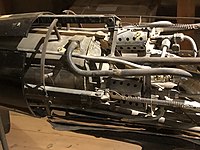
Robert H. Goddard
Robert Hutchings Goddard (October 5, 1882 – August 10, 1945)[1] was an American engineer, professor, physicist, and inventor who is credited with creating and building the world's first liquid-fueled rocket, which was successfully launched on March 16, 1926.[2] By 1915 his pioneering work had dramatically improved the efficiency of the solid-fueled rocket, signaling the era of the modern rocket and innovation. He and his team launched 34 rockets between 1926 and 1941, achieving altitudes as high as 2.6 km (1.6 mi) and speeds as fast as 885 km/h (550 mph).[3]
For other persons with the name Robert Goddard, see Robert Goddard (disambiguation).
Robert H. Goddard
October 5, 1882[1]
August 10, 1945 (aged 62)[1]
American
First liquid-fueled rocket
- Congressional Gold Medal (1959)
- Langley Gold Medal (1960)
- Daniel Guggenheim Medal (1964)
Goddard's work as both theorist and engineer anticipated many of the developments that would make spaceflight possible.[4] He has been called the man who ushered in the Space Age.[5]: xiii Two of Goddard's 214 patented inventions, a multi-stage rocket (1914), and a liquid-fuel rocket (1914), were important milestones toward spaceflight.[6] His 1919 monograph A Method of Reaching Extreme Altitudes is considered one of the classic texts of 20th-century rocket science.[7][8] Goddard successfully pioneered modern methods such as two-axis control (gyroscopes and steerable thrust) to allow rockets to control their flight effectively.
Although his work in the field was revolutionary, Goddard received little public support, moral or monetary, for his research and development work.[9]: 92, 93 He was a shy person, and rocket research was not considered a suitable pursuit for a physics professor.[10]: 12 The press and other scientists ridiculed his theories of spaceflight. As a result, he became protective of his privacy and his work.
Years after his death, at the dawn of the Space Age, Goddard came to be recognized as one of the founding fathers of modern rocketry, along with Robert Esnault-Pelterie, Konstantin Tsiolkovsky and Hermann Oberth.[11][12][13] He not only recognized early on the potential of rockets for atmospheric research, ballistic missiles and space travel but also was the first to scientifically study, design, construct and fly the precursory rockets needed to eventually implement those ideas.[14]
NASA's Goddard Space Flight Center was named in Goddard's honor in 1959. He was also inducted into the International Aerospace Hall of Fame and National Aviation Hall of Fame in 1966, and the International Space Hall of Fame in 1976.[15]
Personal life[edit]
On June 21, 1924, Goddard married Esther Christine Kisk (March 31, 1901 – June 4, 1982),[93] a secretary in Clark University's President's office, whom he had met in 1919. She became enthusiastic about rocketry and photographed some of his work as well as aided him in his experiments and paperwork, including accounting. They enjoyed going to the movies in Roswell and participated in community organizations such as the Rotary and the Woman's Club. He painted the New Mexican scenery, sometimes with the artist Peter Hurd, and played the piano. She played bridge, while he read. Esther said Robert participated in the community and readily accepted invitations to speak to church and service groups. The couple did not have children. After his death, she sorted out Goddard's papers, and secured 131 additional patents on his work.[94]
Concerning Goddard's religious views, he was raised as an Episcopalian, though he was not outwardly religious.[95] The Goddards were associated with the Episcopal church in Roswell, and he attended occasionally. He once spoke to a young people's group on the relationship of science and religion.[16]: 224
Goddard's serious bout with tuberculosis weakened his lungs, affecting his ability to work, and was one reason he liked to work alone, in order to avoid argument and confrontation with others and use his time fruitfully. He labored with the prospect of a shorter than average life span.[16]: 190 After arriving in Roswell, Goddard applied for life insurance, but when the company doctor examined him he said that Goddard belonged in a bed in Switzerland (where he could get the best care).[16]: 183 Goddard's health began to deteriorate further after moving to the humid climate of Maryland to work for the Navy. He was diagnosed with throat cancer in 1945. He continued to work, able to speak only in a whisper until surgery was required, and he died in August of that year in Baltimore, Maryland.[16]: 377, 395 [96] He was buried in Hope Cemetery in his home town of Worcester, Massachusetts.[97]




